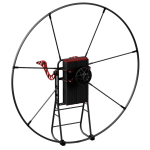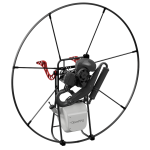Performance & Specs
With this kind of power, the SP140 electric features different power modes (chill and sport), allowing the thrust and responsiveness to be adjusted according to the pilot’s preference.
Flight Time & Batteries
More batteries can be connected in parallel to double the flight time to 2 hours, but this increases the weight, and most pilots will choose to trike launch versus foot launch if they are going to add extra batteries in parallel.
With the typical gas paramotor flight averaging around 40 minutes of flight time, 1 hour of flight time is enough for 95% of pilots to make the switch and enjoy all the benefits of electric.
Faster chargers can be used to charge up in as little as 1 hour. However, if you are looking to fly multiple hours in a row, it’s best to get an extra battery so you can simply swap out batteries.
Operation & Maintenance
Safety & Training
Purchase & Shipping
The cost per hour of runtime with an electric paramotor is about $0.60 versus $11.69 for traditional models. So, after around a few hundred hours of flight time, this could result in thousands of dollars in cost savings.
For orders greater than $12,000, credit cards are no longer accepted due to high fees and fraud risk. For orders below this amount, we accept all types of credit cards.
View full warranty details
Additionally, the SP140 is specifically designed to allow for easy battery swaps, ensuring a seamless experience.
Community & Support
Note: At this time, we aren’t able to offer factory tours.
Current firmware and files can be found on the OpenPPG GitHub or in the config tool config.openppg.com/
Learn more about the SP140 ICE and Electric specs and compare to top gasoline paramotors at our comparison page.
Compare SP140 PPGWe’re adding more information. If you have any other questions or comments, please don’t hesitate to contact us. We strive to respond quickly.
Contact US




